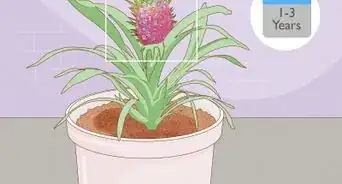This article was co-authored by Maggie Moran. Maggie Moran is a Professional Gardener in Pennsylvania.
This article has been viewed 167,717 times.
When growing season arrives, melons are a favorite fruit to grow and eat. There are many delicious varieties of melon that all require similar conditions for planting and growing, including watermelon, honeydew, cantaloupe and muskmelon. Melons grow best in warm weather, with plenty of sunshine and generously-watered soil. With the right growing conditions and gardening supplies, you’ll be able to grow melons in the summer for a successful harvest by early fall.
Steps
Preparing the Planting Area
-
1Choose a sunny location. Pick a spot outdoors where your seedlings will get full sunshine and plenty of warmth during the day. The ground temperature must be above 70 degrees F (21 degrees C) before you begin planting, or else the seeds will not germinate.
-
2Fertilize your soil. Test your soil to ensure its pH is between 6.0 and 6.8, which ensures there is sufficient calcium levels in your garden. Once your pH levels are correct, fertilize your plant beds using compost or a natural fertilizer from a nursery or home and garden store. This will ensure that your melons are planted in a nutrient-dense environment.Advertisement
-
3Cultivate the area where you will plant the melons. You'll likely need at least a 4x6 foot (1.2x1.8 m) area to grow your melons, so be sure you've cleared sufficient space for your plant beds by removing any sticks or rocks in the vicinity. Prepare the soil in your plant beds by breaking it up with a shovel or a tiller. [1]
-
4Consider starting your melon seeds indoors. If you live in an area with long winters and short summers, it’s best to start growing melons indoors until it is warm enough to transfer your seedlings outside. If you plant indoors, place seeds in containers of compost and peat moss. Transplant your seedlings outdoors once the weather is consistently warm.[2]
Planting the Melons
-
1Plant the melons in late spring after the last frost has passed. Melon seeds will not germinate if the soil temperature is less than 70 degrees F (21 degrees C), so you should determine if and when your local environment will be able to sustain melon growth before buying seeds.[3]
- In most temperate locations, you should begin planting in sometime between late May and early June.
- Don't plant melons if there is a risk of frost. Melon plants will not survive frost and seeds are unlikely to germinate if the soil gets too cold. You must wait until after the last expected frost of spring and allow the wet soil to dry before planting seeds.
-
2Create mounds of dirt in your plant bed. Each mound should be approximately 1 foot (0.30 m) (30 cm) high, and between 2–3 feet (0.61–0.91 m) (60-90 cm) wide. Leave about 1–2 feet (0.3–0.6 m) (30-60 cm) of space between each mound, and space rows about 4 feet (1 m) (120 cm) apart to ensure your melon vines have plenty of space to grow.
-
3Sow 5-6 seeds in each mound of dirt. Your seeds should be planted between 4-6 inches (10-15 cm) below the surface of your dirt mounds. If you are planting seedlings that you started growing indoors, or if you purchased seedlings from a nursery, plant 2-3 seedlings per mound. Saturate the area with water when you are finished planting.
-
4Protect your seeds with mulch, landscaping fabric, or row covers. Especially if you live in a cooler climate, covering the area where you are planting melons with plastic mulch or black landscaping fabric will help preserve the heat in the soil and keep your seedlings warm. You can also cover your plant rows with floating row covers to preserve heat while protecting your seedlings from pests.
- If you plant melon starters (or if you're transferring seedlings outside after starting them indoors), it's still encouraged to use some form of insulation to ensure that your plants are warm enough to grow properly.
Maintaining the Melon Plants
-
1Water the melon plants every 2 to 3 days throughout the summer. Your melon plants need at least 1-2 inches (2.5-5.1 cm) of water per week, so make sure you water them more often if the weather is very hot and dry.[4]
- Be careful not to overwater your plants, as this can cause your melons to rot. If water is standing on top of the soil, add some mulch around the melon plants to help absorb it.
- Water your plants less frequently as your melons begin to ripen, as this will allow your fruit to develop more flavor and sweetness.
-
2Fertilize your plants every 3 to 4 weeks. Use a well-balanced fertilizer, which can be purchased at plant nurseries or home and garden stores. You can also make your own compost tea to use. Put your fertilizer or compost in a bucket, and use your hands to sprinkle about 1 tablespoon (14.8 mL) of fertilizer in the dirt around each of your plants.
-
3Monitor your plants for signs of pests or disease. If your plants are being disturbed by bugs or insects, use row covers to keep them away. Watch for any white, powdery patches or spots the leaves or stems of your plants, which are signs of powdery mildew. If your plants are infected with powdery mildew, remove all plant parts that appear affected, and spray the rest of your garden with a fungicide or diluted copper spray.[5]
- To get rid of aphids, spray a diluted insecticide on your plants early in the morning. Repeat as needed.
- If you notice cucumber beetles, set insect traps for them or apply a pyrethrins mix to the soil. Alternatively, use black plastic instead of mulch to protect your plants and keep the pests away.
-
4Harvest your melons. Your melons will be ripe and ready to eat by late summer or early fall. You’ll know your melons are ready for harvest when you can smell the melon through the skin.[6]
- Once they’ve been picked from the vine, melons will get softer, but not sweeter.
- If you don’t eat your melons shortly after harvest, they can be stored in the refrigerator for up to 12-15 days.
Expert Q&A
Did you know you can get expert answers for this article?
Unlock expert answers by supporting wikiHow
-
QuestionCan you grow melons indoors?
 Maggie MoranMaggie Moran is a Professional Gardener in Pennsylvania.
Maggie MoranMaggie Moran is a Professional Gardener in Pennsylvania.
Home & Garden Specialist Yes, you can grow melons in a container at least 18 inches deep. Fill the container with a mixture of perlite, peat moss, and potting soil. Place the seedling in the container and cover it with soil. Place the container in a southern-facing window and water frequently. It is advisable to place a trellis for the vines to grow on.
Yes, you can grow melons in a container at least 18 inches deep. Fill the container with a mixture of perlite, peat moss, and potting soil. Place the seedling in the container and cover it with soil. Place the container in a southern-facing window and water frequently. It is advisable to place a trellis for the vines to grow on. -
QuestionCan you grow melons in a container?
 Maggie MoranMaggie Moran is a Professional Gardener in Pennsylvania.
Maggie MoranMaggie Moran is a Professional Gardener in Pennsylvania.
Home & Garden Specialist
-
QuestionCan you grow melons in the UK?
 Maggie MoranMaggie Moran is a Professional Gardener in Pennsylvania.
Maggie MoranMaggie Moran is a Professional Gardener in Pennsylvania.
Home & Garden Specialist
Things You'll Need
- Sunny garden area
- Melon seeds or starters
- Plastic mulch
- Black landscaping fabric or plastic
- Floating row covers
- Fertilizer
References
- ↑ https://www.gardeningknowhow.com/edible/fruits/melons/growing-melons.htm
- ↑ https://www.gardeningknowhow.com/edible/fruits/melons/growing-melons.htm
- ↑ http://mgsantaclara.ucanr.edu/garden-help/vegetables/melons/
- ↑ https://www.gardeningknowhow.com/edible/fruits/melons/growing-melons.htm
- ↑ https://www.almanac.com/pest/powdery-mildew
- ↑ http://mgsantaclara.ucanr.edu/garden-help/vegetables/melons/
About This Article
If you want to plant melons, find a 4 by 6 foot sunny spot in your garden and create mounds of earth in the planting area. Sow 5 seeds in each mound, making sure they are 4-6 inches below the surface. Then, cover the area with plastic mulch to maintain the heat in the soil and keep out pests. As the plants grow, water them at least once every 2-3 days and fertilize them every 3 weeks. If you're unsure when to harvest your fruit, wait until you can smell the melon through the skin. For tips on how to protect your melons from diseases like powdery mildew, keep reading!





































































